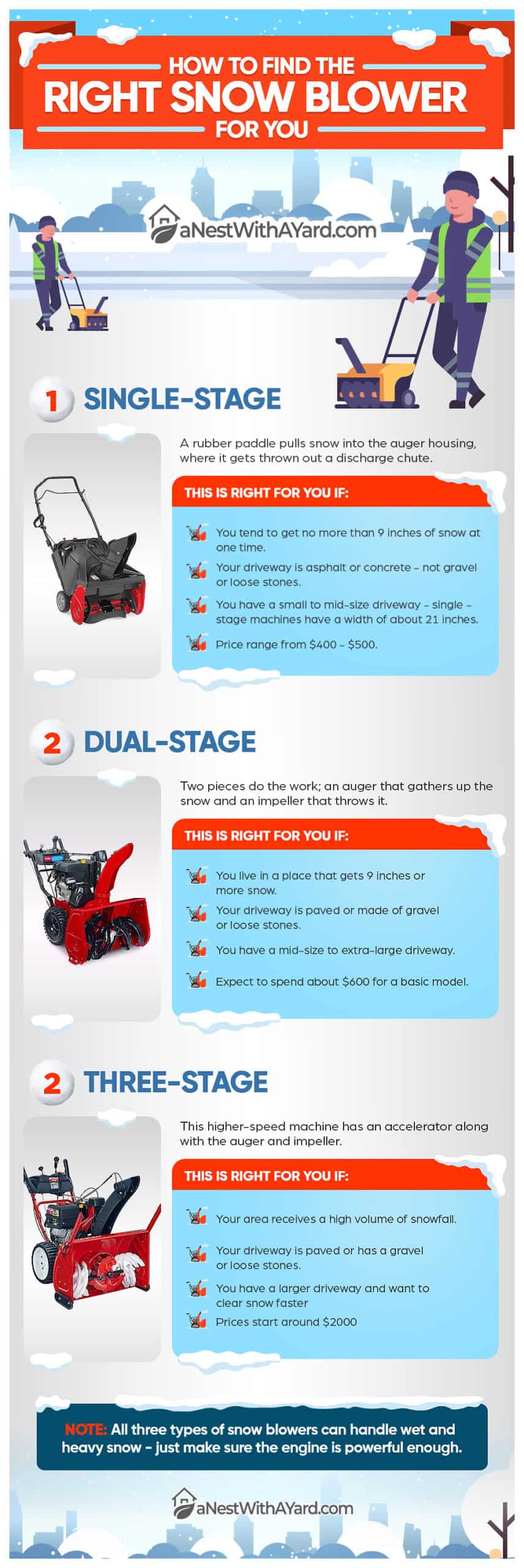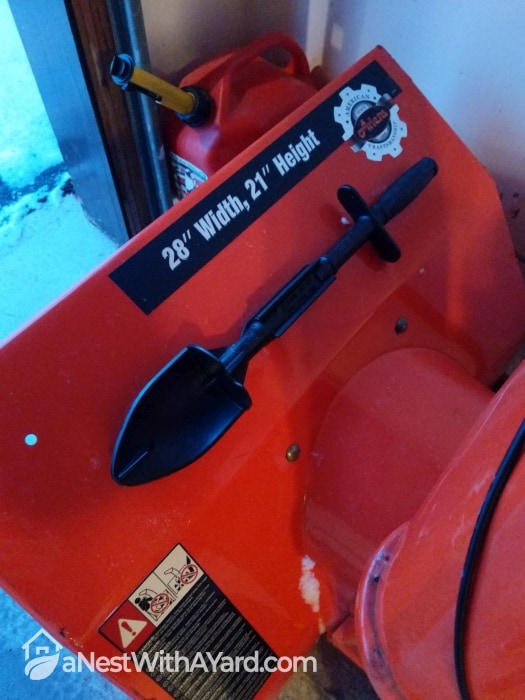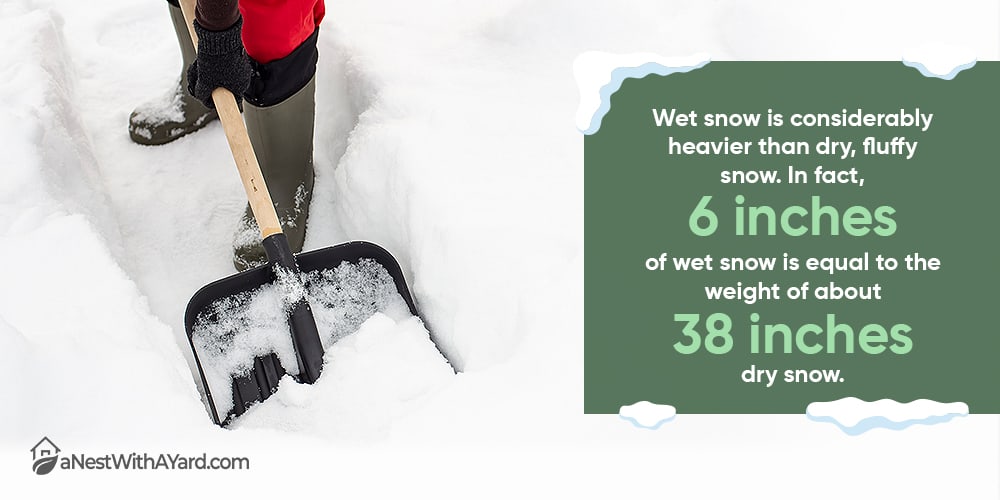Are you a bit confused about how to use a snow blower when the snow is wet? I was too! Not knowing how to keep snowblower from clogging in wet snow can lead to frustration, machine damage, and even finger amputation.
As bad as that sounds, using the right techniques (and machine) can make this task perfectly safe and much easier than shoveling. I did some research on this topic and I want to share with you what I learned.
Keep reading for my 5 tips on how to use a snowblower in wet snow.
Contents
Tip #1: Make Sure You Have The Right Snow Blower
Technique alone won’t get you through a winter with heavy snow. If you don’t have the right snow blower for your driveway and local climate, you’ll need a shovel!
There are three main types of snow blowers:
Single-Stage Snow Blowers
A single-stage snow blower is a basic machine for basic jobs. With this type of machine, the auger (the spiral-shaped blade in the front) simply picks up the snow and tosses it out the chute.
A single-stage blower doesn’t do much to break down chunks of snow and ice, so it isn’t ideal for wet snow. Additionally, in a single-stage snowblower, the auger touches the ground. While this allows it to clean down to the pavement, it makes the machine incompatible with gravel.
Despite being the simplest kind of snow blower, a single-stage snow blower can handle a little wet snow. It might be all you need if you meet these three requirements:
- You have a small-to-medium-sized driveway.
- Your driveway is made of asphalt or concrete.
- Your area rarely gets over 9 inches of snow at a time.
However, if you’re researching how to deal with wet snow, you probably get enough that you should have at least a two-stage snow blower.
It’s also important to consider that most single-stage blowers aren’t self-propelled, which can make them difficult to push up slopes through dense snow.
Two-Stage Snow Blowers
The single-stage blower’s upgraded cousin, the two-stage blower has all the same parts as a single-stage. What makes it more heavy-duty are its power-assisted wheels, two elevated augers, and impeller.
By saving you from having to push the machine, the power-assisted wheels help the snow blower get up hills and clean large areas. Two augers can process more snow than one and their elevation lets them glide over gravel.
The impeller (which looks like a fan) blasts snow through the chute, throwing it faster and farther than the augers could do alone.
For most residential users, a two-stage blower is reliable for wet snow.
Three-Stage Snow Blowers
Unlike a two-stage snow blower, a three-stage blower has an accelerator, a third auger that sits perpendicular to the two collection augers.
The accelerator can move up to 10x faster than the collection augers, allowing a three-stage blower to eat through snow faster than any two-stage blower can.
Consider a three-stage blower if you have to clear a large area or if you often get 12-24 inches of wet snow at a time.
For more info about the differences between different types of snowblowers, read our posts about 1-stage vs 2-stage snowblowers and 2-stage vs 3-stage snowblowers.
Need more help choosing a snow blower? Check out my reviews of the best two-stage and three-stage machines for wet snow.

Tip #2: Coat The Chute With Something Slippery
Dry snow is powdery because its flakes stay frozen solid and separate, so they don’t merge into clumps.
In contrast, wet snow is sticky. When enough wet snow sticks inside your snow blower chute, it will probably clog.
The Risk Of Unclogging A Snow Blower
Cleaning a clogged snow blower is a risky business. Since 2003, about 9,000 Americans have sustained hand injuries from snow blowers — most of these have been amputated fingers!
Even if your snowblower is off, don’t try to unclog it with your hands. A part that appears stopped can suddenly move as soon you remove whatever is obstructing it.
A snow blower will pull in anything, including your hand.
You can safely unclog your snowblower with a tool.

Beware, however, that Dr. Sanj Kakar of the Mayo Clinic has seen wrist injuries in people who tried to clean their snow blowers with sticks!
He advises against unclogging a snow blower through any method other than just letting the snow melt on its own.
How To Keep Snowblower From Clogging
Fortunately, wet snow glides right off a non-stick coating. While your chute (or impeller) is dry, coat it with any of the following:
- Teflon-based spray
- Silicone spray lube
- WD-40
- Spray-on automotive or ski wax
Note that although it takes more time to wax a chute than to oil it, wax tends to last longer.
Doug Doing Demos has a helpful video on how to apply silicone lubricant to your snow blower:
Personally, my favorite spray is the DuPont Teflon Snow and Ice Repellant. To learn why, read the buying guide and review by A Nest With A Yard on this product and another good spray.
Tip #3: Move Slowly
You may be tempted to go quickly through wet snow, but that’s a surefire way to clog it.
Ultimately, if you go too fast, you’re going to spend more time, in the long run, cleaning your snow blower chute. You may also wear out your machine, especially the drive belts.
In wet snow, manufacturers recommend moving your snow blower in increments of one-third to one-half of its width.

If you hate going that slow, you can try pausing every five feet and let your machine discharge the accumulated snow. This method will only work if the snow cover isn’t too deep.
For really heavy snowfall, you might have to move at a snail’s pace with this two-push method demonstrated by John Pearson.
Pacing Yourself Is Healthy
Don’t overexert yourself in cold temperatures. This is especially important if you have heart problems, diabetes, or high blood pressure. If you have any of these conditions, you should consult your doctor before even using a snow blower.
In cold temperatures, your blood vessels constrict to help your body save heat. This causes your body to work harder to get enough oxygen.
When your blood vessels constrict, they raise your blood pressure and force blood platelets closer together. If your blood platelets are sticky, due to factors such as age, lifestyle, and diabetes, the confined space makes them more likely to clot.
Cold weather increases the risk of heart attacks, strokes, and other health emergencies. In just one day, a temperature drop of just 1.8F/1.0C can cause 200 heart attacks. In fact, there are 53 percent more heart attacks in the winter than in the summer!
So basically, you can’t go wrong with taking your time to clear wet snow. You should also make sure you take breaks as you go along.
Tip #4: Throw Wet Snow As Far As You Can
As tedious as it is to clear wet snow, you aren’t going to want to do it twice because you didn’t throw it far enough!
Of course, throwing heavy snow is tricky. Here are four ways you can throw snow further:
Take In Less At A Time
This may seem fairly logical, but it’s an easy mistake to make when you are trying to get the job done quickly so you can get back inside where it’s warm.
But for the best efficiency, you need to take in less snow at a time, so your machine can concentrate its throwing power on lighter loads of snow.
Run Your Machine At Full Throttle, But Slowly
It’s easy to confuse engine speed with ground speed, but your machine can aggressively process snow while moving very slowly.
If your machine is self-propelled, it should have a shift lever marked with different numbers for ground speed. In wet snow, you should choose a low speed, so your blower only takes in a little snow at a time.
This video demonstrates the shift lever, as well as other snow blower parts:
Your snow blower should have a throttle (engine speed) control that is marked with a turtle for slow and a rabbit for fast (In the video above, you can see it at 1:05).
Set the control to full-throttle for optimum performance and fuel efficiency.
Fully Raise The Chute Diverter
Your machine’s chute diverter can aim the dispersed snow at different heights, depending on your machine. Throwing wet snow higher will allow it to travel a bit farther before touching the ground.
Use Wind To Your Advantage
If you blow snow in the same direction the wind is blowing, the wind will carry it out a little farther. Of course, ignore this advice when the wind is blowing towards the street or people!
Have Mechanical Skills? Here’s An Extra Option:
CAUTION: You can lose fingers by touching your machine’s impeller. Use this option at your own risk and only if you know what you are doing.
Make sure the spark plug is removed and that the machine has been off long enough to be completely still. If you are unsure of your safety, either hire a professional or skip this project.
If you are comfortable modifying your snow blower, Youtuber Sixtyfiveford has an ingenious solution to make it throw snow much farther:
He explains that there is empty space around the impeller to keep it from scraping the housing around it. This empty space allows snow to build up, which leads to clogging.
With pieces of rubber, you can modify the blades to harmlessly rub against the housing. This makes clogging around the blades impossible and boosts their throwing power.
Tip #5: Clear Wet Snow At The Right Time
Clear It Early In The Day

Only a little moisture makes the difference between dry snow and wet snow. Whereas dry snow is, at most, 10 percent water, wet snow is at least 20 percent water (hybrid snow is in between these percentages).
Since snow can melt quickly, there’s no better time to clear it than right before dawn, when the sun’s been down all night and the temperature is at its coldest. Just don’t start too early if you have neighbors, since snow blowers are loud.
Clear It Before It Reaches Six Inches In Height
Weather permitting, you don’t have to let wet snow pile up before you deal with it.
Be sure to clear snow before it can reach six inches in height. Though you’ll spend more time outside, your snow blower will have an easier time and throw the snow further.
This technique also prevents snow from hiding things that could damage your machine. Most snow blower jams are caused by frozen newspapers, which can damage shear pins, belts, augers, and impellers.
How To Use A Snowblower In Wet Snow? Now You Know!
You now know how to use a snowblower in wet snow. With these five tips, you can protect your machine from wear and tear, as well as avoid clogging the chute.
If you want to learn more, head over to the post with snow blowing tips.
Did you enjoy reading this listicle? If so, please share it! Please also feel free to leave any feedback in the comments.





I really need to start a blog myself. Everyone just keeps borrowing info and videos from others (I don’t care that you give them credit). It’s always the same basic info provided. Nothing new or unique from the blogger. When stating ‘Some Of The Best Snowblowers For Wet Snow” or the ‘best’ of anything you really should provide details as to what you think makes it the best. Or at the very least do your own actual review by testing each model you write about and providing personal views. Otherwise it’s meaningless to someone like me, but I guess when you get paid for the adverts etc. no one really cares about the info being presented and certainly not whether anyone else would benefit from it. What a shame. i really will look into blogging about anything pretty much. thanks